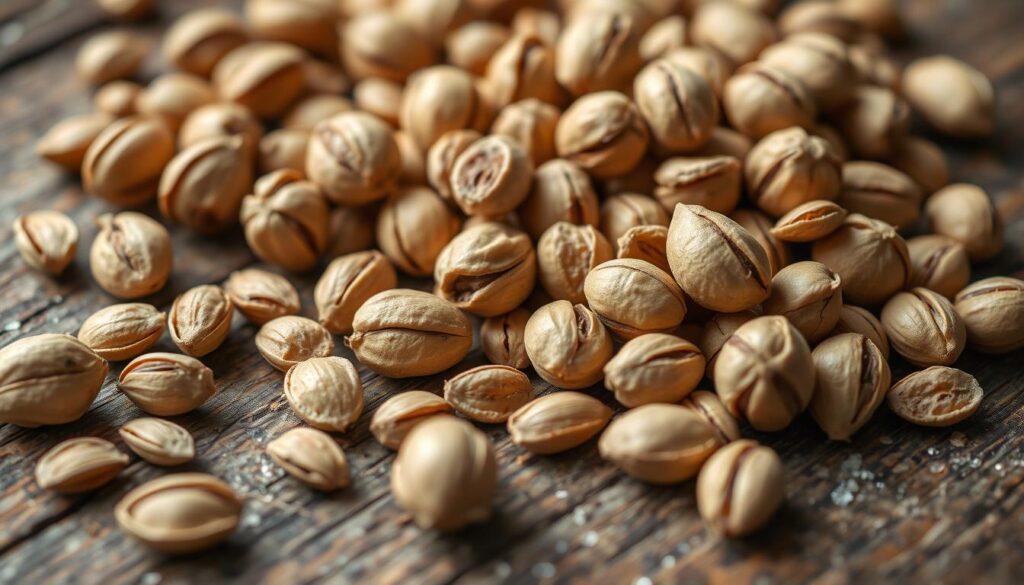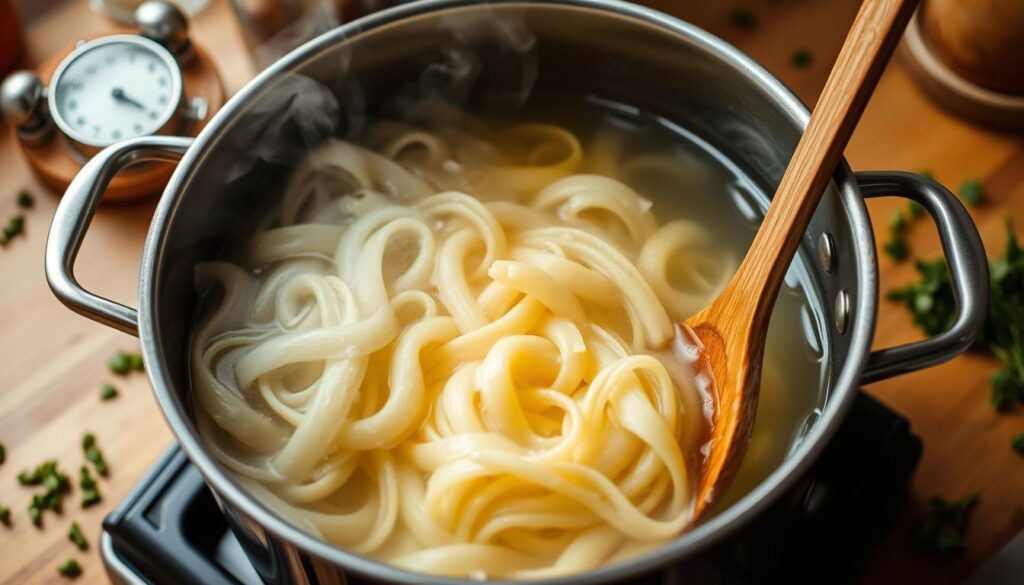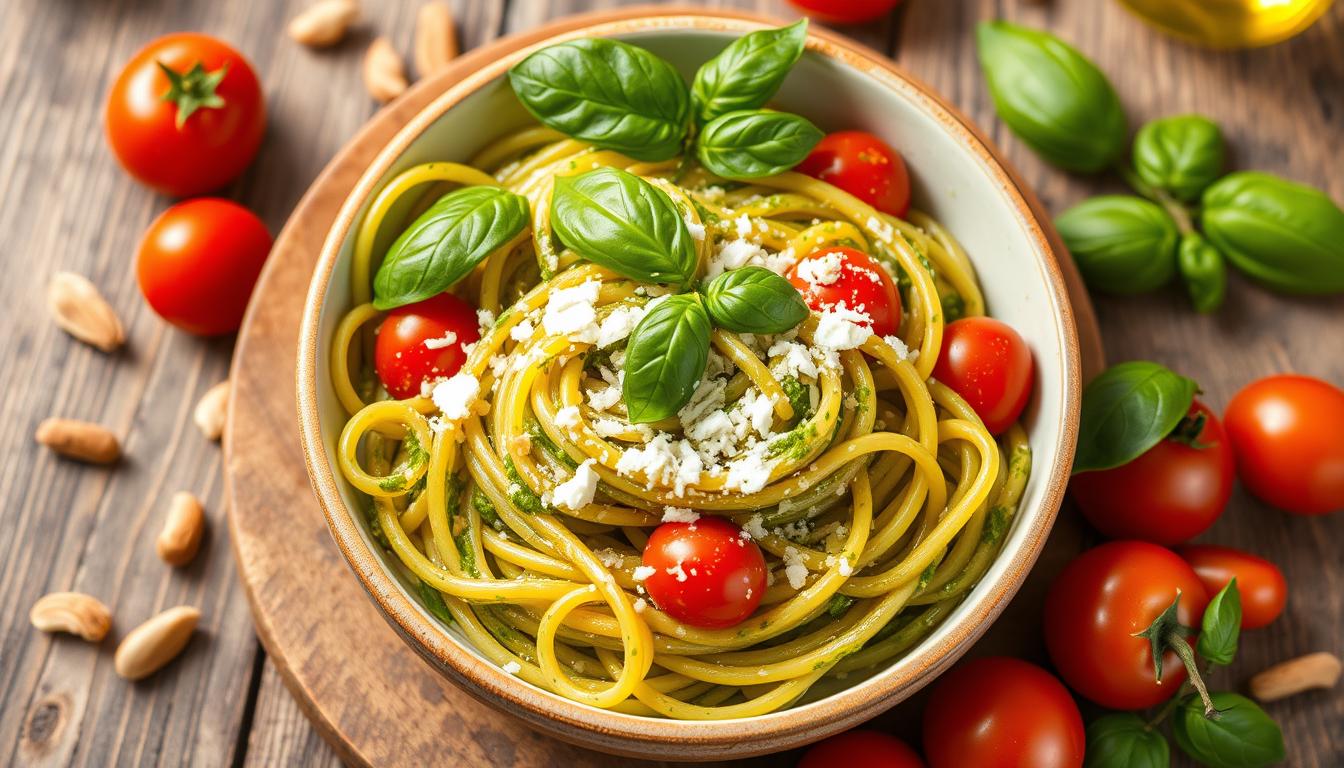This post contains affiliate links.
Imagine it’s a warm summer evening, and your kitchen smells like fresh basil. You’re looking for a tasty meal without spending hours in the kitchen. That’s where this basil pesto pasta recipe comes in handy. It’s a classic Italian dish that’s great for busy weeknights.
This recipe is all about quick, tasty meals with simple, fresh ingredients. In just 25 minutes, you’ll have a vibrant green pasta full of flavor. It’s like eating at a cozy trattoria, but in your own kitchen.
So, what makes this pesto pasta stand out? It’s the perfect mix of creamy pesto, al dente pasta, and crunchy pine nuts. Plus, you can make it your own. Whether you’re vegetarian, vegan, or just want more veggies, this recipe is for you.
Key Takeaways
- Prep and cook time totals 25 minutes for a quick dinner
- Recipe rated 5/5 stars by 41 voters
- Uses fresh basil, pine nuts, and quality Parmesan for authentic flavor
- Easily customizable with different nuts, greens, or pasta shapes
- Serves 2, perfect for a cozy dinner or easy to scale up
- Nutritious meal with healthy fats and vitamins from fresh ingredients
- Can be stored and reheated for convenient leftovers
Introduction to Basil Pesto Pasta
Basil pesto pasta brings the Mediterranean diet to your table. It’s quick and easy to make. The dish combines fresh herbs, olive oil, and cheese for a meal that’s both tasty and healthy.
What is pesto pasta?
Pesto pasta mixes al dente pasta with a vibrant green sauce. This sauce is made from fresh basil, pine nuts, garlic, olive oil, and Parmesan cheese. It coats the pasta, giving each bite a burst of flavor.
With just 3 cups of basil leaves, 2 cloves of garlic, and 1 cup each of olive oil and Parmesan, you can make about 3 cups of pesto sauce. This is enough to coat a pound of pasta perfectly.
Why this recipe is a game-changer
This basil pesto pasta recipe is perfect for busy cooks. It takes only 10 minutes to prep and 5 minutes to cook. You can have a delicious meal ready in 15 minutes.
It’s also versatile. Try it with chicken for extra protein, use it as a sandwich spread, or freeze it for later. The nut-free version is great for those with allergies, yet still tastes like classic pesto.
Brief history of pesto in Italian cuisine
Pesto comes from Genoa, Italy, and is known as Genovese sauce. It’s been a key part of Italian food for centuries. Originally made with a mortar and pestle, now it’s blended for quicker prep.
The Mediterranean diet, known for its health benefits, often includes this tasty sauce. It’s a main ingredient in many dishes.
Ingredients for Perfect Basil Pesto Pasta
Creating the perfect basil pesto pasta starts with picking top-notch ingredients. This dish, loved by 377 voters, is easy to make and packed with fresh flavors. It’s ready in just 15 minutes.
Fresh basil: The star of the show
Fresh basil is the key to a great pesto. You’ll need 2 cups of it for this recipe. This herb adds a bright, peppery taste that’s essential for the sauce.
Pine nuts: Traditional vs. alternative options
Pine nuts are classic in pesto, and you’ll need ½ cup. But, you can swap them with walnuts, almonds, or pistachios. For a nut-free choice, pepitas or hemp seeds are good alternatives.

Selecting the right pasta shape
Linguine is a top pick for pesto, but penne or spaghetti also work well. These shapes let the sauce stick perfectly, making every bite tasty. For something lighter, angel hair pasta is a good choice.
Quality Parmesan cheese: Why it matters
A quarter cup of fresh Parmesan cheese makes a big difference. It brings a salty, nutty taste that goes great with basil. For a vegan option, nutritional yeast is a great swap.
| Ingredient | Amount | Purpose |
|---|---|---|
| Olive oil | ¼ cup | Binds ingredients, adds richness |
| Garlic | 1 small clove | Adds depth and zest |
| Lemon juice | 2 tablespoons | Brightens flavors |
| Sea salt | ¼ teaspoon | Enhances overall taste |
With these top ingredients, you’re set to make a delicious basil pesto pasta. It serves 4 and is full of flavor in every bite.
Step-by-Step Guide to Making Basil Pesto
Making homemade pesto is quite simple. Just follow a few steps, and you’ll have a tasty sauce in about 5 minutes. Let’s get started on this Italian classic.
Begin by toasting pine nuts in a small skillet until they turn golden brown. This step boosts their flavor and enriches your pesto. After cooling, add them to your food processor or blender with fresh garlic cloves and basil leaves.
Pulse the mix until it turns into a smooth paste. Slowly pour in olive oil while blending to achieve a creamy texture. Your food processor or blender will mix all the flavors well.
Move your pesto to a bowl and mix in freshly grated Parmesan cheese, salt, and pepper. The cheese adds a savory touch that goes well with the basil.
“Fresh ingredients are key to a flavorful pesto. Use the best quality basil, olive oil, and Parmesan you can find.”
Keep your homemade pesto in an airtight container in the fridge for up to 5 days. If you want to keep it longer, freeze it for 9-12 months. This way, you can enjoy your fresh garden basil pesto all year.
| Ingredient | Quantity | Purpose |
|---|---|---|
| Fresh Basil Leaves | 2 cups | Main flavor base |
| Pine Nuts | 1/3 cup | Adds nutty texture |
| Garlic Cloves | 2 medium | Aromatic enhancer |
| Extra-Virgin Olive Oil | 1/2 cup | Binds ingredients |
| Parmesan Cheese | 3/4 cup | Adds savory depth |
Cooking the Pasta to Al Dente Perfection
Mastering al dente pasta is key to making your pesto dish stand out. Let’s explore the key techniques for cooking pasta that will elevate your meal.
Salting the Water: A Crucial Step
Begin by boiling a large pot of water. Add 1 tablespoon of salt for every 4 quarts of water. This step is crucial for boosting the pasta’s flavor.
Timing Your Pasta Cooking
Each type of pasta has its own cooking time. Dried pasta usually takes 8-10 minutes, while fresh pasta cooks in 1-3 minutes. For al dente, look for a firm center with a bit of chew.
| Pasta Type | Cooking Time | Portion Size |
|---|---|---|
| Dried Pasta | 8-10 minutes | 100g per person |
| Fresh Pappardelle | 2-3 minutes | 150g per person |
| Orecchiette | 3-4 minutes | 100g per person |
Reserving Pasta Water: The Secret Ingredient
Before draining, save about 1/2 cup of pasta water. This starchy liquid is key for a smooth, cohesive sauce when mixed with pesto.

Don’t rinse your pasta or add oil to the cooking water. These steps can stop your sauce from sticking. Instead, mix your al dente pasta with the pesto for a perfect flavor blend.
Combining Pesto and Pasta: Techniques for Best Results
Are you ready to make the perfect pesto pasta? Let’s explore how to mix these two tasty elements. First, cook your pasta until it’s al dente, then drain it and put it back in the pot.
Next, add about half of your pesto to the pasta. You can always add more later. Start tossing the pasta with the sauce, making sure every strand gets coated. If the sauce is too thick, add a little pasta water – about 1/4 cup to start.
Keep tossing until the pesto sauce coats the pasta smoothly. The pasta water makes the sauce cling better and gives it a silky feel. If you want more sauce, add more pasta water or pesto.
For an extra special dish, try this: Mix 1 cup of pesto with 1 cup of heavy cream in a skillet. Cook it for 5-7 minutes until it thickens a bit. Then, toss this creamy pesto sauce with your pasta for a truly indulgent meal.
| Ingredient | Amount | Purpose |
|---|---|---|
| Pasta | 16 ounces | Base of the dish |
| Pesto Sauce | 1 cup | Main flavor component |
| Reserved Pasta Water | 1/4 to 1/2 cup | Adjusts sauce consistency |
| Heavy Cream (optional) | 1 cup | Creates creamier sauce |
The secret to great pesto pasta is in the tossing. Take your time, be gentle, and enjoy making this classic Italian dish!
Customizing Your Basil Pesto Pasta
Pesto pasta is a dish that you can make your own. You can change it into many vegetarian pasta dishes. This way, you can meet different tastes and dietary needs.
Adding Vegetables for Extra Nutrition
Add more nutrients to your pesto pasta by using colorful veggies. Try adding cherry tomatoes for a fresh taste, or roasted cauliflower for a nutty flavor. Asparagus brings a crisp texture and goes well with the creamy pesto sauce.
Protein Options for a Complete Meal
Make your vegetarian pasta more filling by adding protein. Grilled chicken or shrimp are great choices. For those who prefer plant-based, tofu or chickpeas are good options. They keep the dish vegetarian and add more protein.
Adjusting Flavors
Enhance your pesto pasta with easy flavor changes. A squeeze of lemon juice makes it brighter, while red pepper flakes add heat. For cheese lovers, extra Parmesan adds a savory taste. Vegans can use nutritional yeast as a cheese substitute, keeping the umami flavor.
- Try cashews instead of pine nuts for a cost-effective twist
- Experiment with different greens like spinach or kale in your pesto
- Use gluten-free or bean-based pasta for dietary restrictions
The best part of pesto pasta is how you can change it up. With these ideas, you can make a new dish every time you cook.
Serving Suggestions and Presentation Tips
Make your Italian food look great with these easy tips for garnishing pasta. Serve your basil pesto pasta right after mixing to keep its bright flavors. Use a big, shallow bowl for family-style serving or individual bowls for a fancy look.
For a rich taste, sprinkle extra Parmesan cheese on top. Add toasted pine nuts for a crunchy bite and fresh basil leaves for color. A drizzle of high-quality olive oil adds a luxurious shine and boosts the flavors.
For a full meal, serve your pesto pasta with a crisp salad or warm garlic bread. This mix of tastes and textures will wow your guests and please their palates. Remember, how you present your dish is important in Italian cuisine, so arrange it nicely before serving.
- Use a large head of cauliflower for a unique twist
- Incorporate 2 tablespoons of nutritional yeast for added umami
- Add a scant tablespoon of white miso for depth of flavor
- Sprinkle ½ teaspoon each of onion and garlic powder for extra zest
With these serving tips, your basil pesto pasta will look and taste amazing. It will surely impress everyone.
Nutritional Benefits of Basil Pesto Pasta
Basil pesto pasta is not only tasty but also full of nutrients that fit the Mediterranean diet. It’s a top choice for those looking for healthy pasta dishes. It brings together great flavors and health perks.
Healthy Fats from Olive Oil and Pine Nuts
Pesto’s key ingredients make it nutritious. A 1/4 cup of pesto has about 263 calories and 24 grams of fat. But don’t worry about the fat! Most of it is from healthy unsaturated fats in olive oil and pine nuts.
Antioxidants in Fresh Basil
Fresh basil, the main ingredient in pesto, is full of antioxidants. These help protect your cells and might lower the risk of some diseases. Basil also has vitamins A and C, which boost your immune system and keep your skin healthy.
Balancing the Meal with Additional Sides
To make a complete meal, add vegetable sides to your pesto pasta. This adds more nutrients and helps with portion control. A little pesto (1-2 tablespoons) can flavor your pasta well without adding too much sodium or calories.
| Nutrient | Amount per 1/4 cup |
|---|---|
| Calories | 263 |
| Protein | 6g |
| Fat | 24g |
| Carbohydrates | 6g |
| Sodium | 380mg |
| Calcium | 193mg |
By making pesto at home, you can control the ingredients and sodium. This lets you enjoy this tasty dish as part of a balanced Mediterranean-inspired diet.
Storing and Reheating Leftover Pesto Pasta
Learning how to store and reheat your pesto pasta keeps it tasty. Put your pesto pasta in an airtight container in the fridge for up to two days. This keeps the flavors fresh and the pasta good.
To reheat your leftovers, separate the pasta from the pesto first. Warm the pasta in simmering water, then mix it with the pesto again. This way, the pesto stays vibrant and doesn’t break down.
Reheating pasta can also be good for you. A study at the University of Surrey found reheated pasta might have fewer calories. The reheating changes the pasta’s starch, making it like high-fiber pasta and helping control blood sugar levels.
Here’s a quick guide to different reheating methods:
| Method | Duration | Best For |
|---|---|---|
| Sautéing | 3-5 minutes | Crispy texture |
| Microwaving | 1-2 minutes | Quick reheating |
| Oven baking | 15-20 minutes | Large portions |
Reheat only what you’ll eat to keep the taste and texture great. With these tips, you’ll love your pesto pasta just as much the second time!
Conclusion
Basil pesto pasta is a favorite among easy Italian recipes. It’s a quick dish that combines great taste, health benefits, and versatility. With a few simple ingredients, you can make a meal for four that everyone will enjoy.
The secret of basil pesto is its easy recipe and health perks. It’s full of vitamins A and K from basil, protein from pine nuts, and calcium from Parmesan cheese. You can also add grilled chicken, cherry tomatoes, or sautéed veggies to make it even better. This makes it perfect for both quick dinners and gatherings with friends.
Anyone can make basil pesto pasta, whether you’re new to cooking or a pro. Its roots in Genoa, Italy, give it a genuine touch. And its flexibility makes it a modern favorite. So, why not try this classic, tasty, and fast pasta dish in your kitchen tonight?
FAQ
What makes this basil pesto pasta recipe a game-changer?
What are the key ingredients in basil pesto?
Can I substitute the pine nuts with something else?
Why is it important to reserve some of the pasta cooking water?
How can I make a creamier pesto sauce?
What are some ways to customize the basil pesto pasta?
How should I serve basil pesto pasta?
What are the nutritional benefits of basil pesto pasta?
How do I store and reheat leftover pesto pasta?
This post contains affiliate links.

